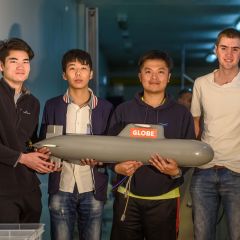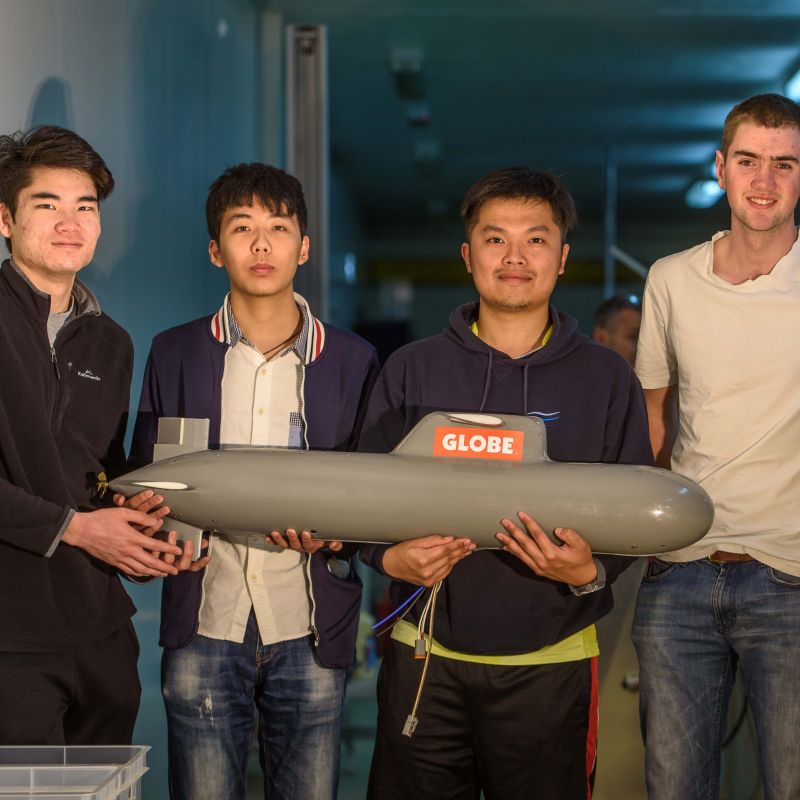Budding engineers have been putting their theory work into practice using AMC’s world-leading education and research facilities as they compete in a series of annual undergraduate design competitions.
The major assessments for the first, second and third-year students at the National Centre for Maritime Engineering and Hydrodynamics saw teams compete in four design categories – the Rat Trap Boat Race, Submarine Design, Skateboard Design and Boat Building projects.
Rat trap boats
The Rat Trap Boat Race challenges students to develop a vessel that can travel a 10 metre course in the model test basin within 30 seconds, powered only by a single rat trap.
Student Sean Kebbell said key design factors were the hull shape and type, propulsion methods and harnessing the power of the rat trap as effectively as possible.
“We designed our vessel using CAD and it was created using a laser cutter. This allowed our boat to be very precise, resulting in the boat going dead straight.”
The vessel designed by Sean’s team was a relative success, completing the 10 metres in 37.5 seconds, placing them second to a fourth-year student.
Being first across the line isn’t the only determinant of success, with Sean identifying the team members were definitely building skills to use in a future career, but also in life.
“From a first glance these projects are subject based, but looking back from completion they are so much more. They are projects that teach life skills and most importantly, team work skills that we are always going to need when we get into industry.”
Submarine design
Third-year naval architecture students got some hands-on experience in the fast-growing naval construction sector, designing, building and testing a scale model submarine.
This team project-based learning activity is a formal assessment of the underwater vehicles technology unit.
The model submarines had to be watertight to a depth of one metre and were assessed on criteria including their stability, navigation and diving abilities. The hydrodynamic hulls were manufactured using the numerically controlled router of the School of Architecture and AMC’s vacuum moulding facility.
The teams used the towing tank to test the underwater resistance calculations of their models, before conducting commissioning trials in the survival centre swimming pool.
Lecturer Dr Roberto Ojeda said the design project was extremely relevant to the fast-paced development of the naval shipbuilding industry, and aligns well with the future needs of the sector.
“The project enables the students to brush up on the peculiarities of the naval industry, and to see how knowledge learned in the naval architecture program can be applied to real-world design,” he said.
“Other units of the naval architecture program provide the students with all the necessary tools. In underwater vehicles technology, we teach them how to apply these tools to the special case of submarine and AUV design.”
Skateboard design
Another category in the competitions is the Skateboard Design project, where students are required to design and test a composite panel suitable as a skateboard deck.
This project serves to introduce students to the important properties and applications of composite materials in a wide range of engineering technologies. Students are required to fine tune flexural and strength properties during the design stage in order to achieve specific properties.
The final judging is by street testing, which adds a subjective element, as no two skaters will respond to a board in the same way. A board is deemed to be successful when the flex, strength and balance suits the riders’ expectations.
Lecturer Denis Lisson says upon completion of the project, the students gain valuable experience in working as a team, which is so important for their future employment opportunities.
“Apart from enhancing their understanding of the underpinning principles of materials engineering, the hands-on project encourages collaboration and motivation,” Mr Lisson said.
Boat building
In the Boat Building design project, second-year students must design and construct a model boat, culminating in a wet test simulation.
The wet test sees the vessels subjected to waves and calm water dynamic testing and stability testing.
Lecturer Fred Barrett believes the hands-on learning is the key to success.
“I run a lot of videos to get them to tune into watching real life stuff, we don’t dwell on text books. Seeing and feeling is the best way to teach and can keep the interest levels high,” Mr Barrett said.
The importance of team work identified in all projects is a sentiment echoed by Dr Christopher Chin, Deputy Director (Students & Education), National Centre for Maritime Engineering and Hydrodynamics.
“Many employers view team dynamics, ethical awareness and leadership as high priorities,” Dr Chin said.
“When working in industries, most projects are team oriented. Thus, it is important that these skills are teased out in team projects.”
Published on: 13 Dec 2017

